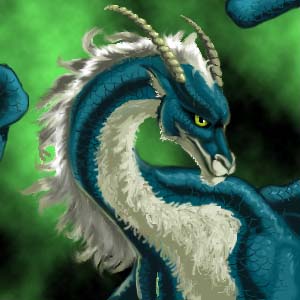


 This legendary creature has been known for its tremendous size, strength, fire-blowing
abilities, guardianship of vast sums of gold and treasures while being seen as a creature
of courage and intelligence. It is also known for having strong links with the elements,
particularly with Earth. However, at one point, they were considered a symbol for destruction
and evil. Greeks and Romans believed that they had the ability to understand and
to teach mortals the secrets of the earth. Because of this duality, destructive and
positive influence, dragons were often adopted as military emblems. The Romans used them
in the first century AD. The folklore of northern Ireland contains a similar interpretation of
the dragon. The ancient Celts considered the dragon a symbol of sovereignty. The Teutonic
invaders of Britain had dragons depicted on their shields. The dragon also figures in the
folklore of Japan.
This legendary creature has been known for its tremendous size, strength, fire-blowing
abilities, guardianship of vast sums of gold and treasures while being seen as a creature
of courage and intelligence. It is also known for having strong links with the elements,
particularly with Earth. However, at one point, they were considered a symbol for destruction
and evil. Greeks and Romans believed that they had the ability to understand and
to teach mortals the secrets of the earth. Because of this duality, destructive and
positive influence, dragons were often adopted as military emblems. The Romans used them
in the first century AD. The folklore of northern Ireland contains a similar interpretation of
the dragon. The ancient Celts considered the dragon a symbol of sovereignty. The Teutonic
invaders of Britain had dragons depicted on their shields. The dragon also figures in the
folklore of Japan.
In China it is traditionally considered as a symbol of good fortune, and was the national
emblem of the Chinese Empire. Unlike the dragons of other cultures, chineses dragons
(called Lungs) were benevolent and brought rain, guarded sacred dwellings, and performed
other such tasks.
There were four types:
1.The Tien Lung, or Celestial Dragon
2.The Fu Tsang Lung or Treasure Dragon
3.The Ti Lung, or Earth Dragon
4.The Shen Lung. or Rain Dragon (also called Kung Kung)
The latter two Lungs are together known as the Wang Lung, and are propitiated as water
deities, dwelling in the Seas.........MORE TO COME

Images provided by:



Site Directory
Myths Directory






 This legendary creature has been known for its tremendous size, strength, fire-blowing
abilities, guardianship of vast sums of gold and treasures while being seen as a creature
of courage and intelligence. It is also known for having strong links with the elements,
particularly with Earth. However, at one point, they were considered a symbol for destruction
and evil. Greeks and Romans believed that they had the ability to understand and
to teach mortals the secrets of the earth. Because of this duality, destructive and
positive influence, dragons were often adopted as military emblems. The Romans used them
in the first century AD. The folklore of northern Ireland contains a similar interpretation of
the dragon. The ancient Celts considered the dragon a symbol of sovereignty. The Teutonic
invaders of Britain had dragons depicted on their shields. The dragon also figures in the
folklore of Japan.
This legendary creature has been known for its tremendous size, strength, fire-blowing
abilities, guardianship of vast sums of gold and treasures while being seen as a creature
of courage and intelligence. It is also known for having strong links with the elements,
particularly with Earth. However, at one point, they were considered a symbol for destruction
and evil. Greeks and Romans believed that they had the ability to understand and
to teach mortals the secrets of the earth. Because of this duality, destructive and
positive influence, dragons were often adopted as military emblems. The Romans used them
in the first century AD. The folklore of northern Ireland contains a similar interpretation of
the dragon. The ancient Celts considered the dragon a symbol of sovereignty. The Teutonic
invaders of Britain had dragons depicted on their shields. The dragon also figures in the
folklore of Japan.